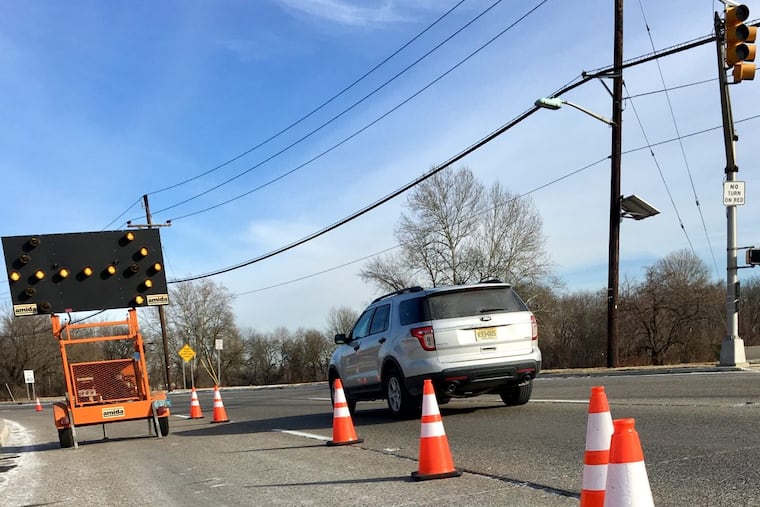Route 130: the `deadliest, most dangerous, most terrifying" road in South Jersey
A young pedestrian's death has helped focus attention on safety issues along Route 130, particularly in Burlington County, where dense residential and commercial development lines the busy highway.

Route 130 is often described as the deadliest, most dangerous, or even the most terrifying road in South Jersey.
Advocates working to make the highway safer say it's especially hazardous for pedestrians and bicyclists.
Crashes along a single 25-mile segment of the mostly six-lane highway from the Airport Circle in Camden County to Farnsworth Avenue in Burlington County claimed 29 lives between 2009 and 2013.
More than half of those who died — 16 — were not mortally injured while driving or riding in vehicles, but while walking across or along the highway; another was riding a bicycle.
The Delaware Valley Regional Planning Commission has been studying these incidents and will make pedestrian and bike safety improvement recommendations to the New Jersey Department of Transportation, which is responsible for maintaining 130. Other public and private agencies, as well as lawmakers from both parties, are seeking solutions as well.
"This concentration of pedestrian and bicycle crashes on Route 130 is not common," said Kevin Murphy, the planning commission's manager of safety programs. "Many of them occurred at intersections where people were crossing, and many of these people were in the crosswalk."
Burlington City High School student Antwan Timbers was not even on the pavement when he was hit by a car while walking along 130 near the school after midnight on May 22, 2016.
The death of the popular 17-year-old shook the community and transformed students into eloquent pedestrian safety advocates who have helped put the issue on the map.
"The kids have been a fantastic boost to our [Route 130] initiative," said Burlington County Sheriff Jean E. Stanfield, whose department also is working with local police departments along the highway to enforce speed limits and remind pedestrians to obey signals.
And last year NJDOT reduced the number of lanes from six to four and added warning signs to help slow traffic on 130 around the school, which stands next to the highway at Jacksonville Road.
Reducing the number of lanes, a tactic referred to as a "road diet," could be among the approaches used elsewhere along 130, which carries as many as 45,000 vehicles a day in some spots in Burlington County.
If you spend time traveling in the slow lane on 130 from Cinnaminson to Burlington City, as I did on a chilly but pre-snowy afternoon last week, the problems pedestrians and cyclists face are obvious.
Sidewalks and shoulders come and go. The distance between crosswalks is often epic. There are few if any islands where pedestrians stranded by light changes can safely wait. Many drivers well exceed the 40- to 50-mph speed limit.
This became dramatically evident when I pulled over into a local outpost of a legendary convenience-store chain and stood on 130's roaring edge.
A few miles up the road, I stepped out of the car again and happened to meet Emiko Swain as she crossed northbound 130 with her 15-year-old daughter, Niah.
"Some people act like they don't want to stop," said Swain, 36, who was walking her daughter home from school. "Some cars that were going fast almost hit my daughter a couple of times."
The highway once commonly known as Burlington Pike was built in stages beginning nearly a century ago and remains "an essential road" for many, said Dana Dobson, South Jersey coordinator for the Tri-State Transportation Campaign.
The nonprofit advocacy organization has designated 130 as the state's "deadliest" highway for pedestrians six years in a row. Dobson said studies show folks trying to get across these wide intersections in time often end up dodging vehicles making left turns from busy cross streets.
Some of the pedestrians are NJ Transit riders who live in the densely populated communities that line the highway on either side. Meaning they're likely to cross the highway daily.
"At a minimum, the entire 130 corridor needs sidewalks," said John Boyle, of Edgewater Park, research director for the Bicycle Coalition of Greater Philadelphia. "People are walking on the shoulders. Or in the mud."
Poor lighting along many stretches of the highway doesn't help, and there's a need for more signs reminding drivers to protect the safety of pedestrians and cyclists.
Changing the behavior of everyone who uses 130 "is like chipping at an iceberg. … It's going to take time and it's going to take a lot of repetition," noted Bill Ragozine, who heads the Cross County Connection, a transportation management association in Marlton that takes part in New Jersey's Street Smart pedestrian safety program.
"What we're trying to do on Route 130 is at least a first step."
Although Boyle would love to see protected bike lanes along 130, less expensive and more incremental projects seem more likely, and more feasible.
"We need to think more about how to accommodate all users of Route 130, and not just drivers," said the planning commission's Murphy.
Even Jersey drivers can learn to accommodate, too: I remember being amazed when I visited California in the '80s and saw drivers stop to allow pedestrians to cross.
I remember thinking, This can't possibly work in Jersey.
But it has. At least in some places. And someday, maybe even along Route 130, too.